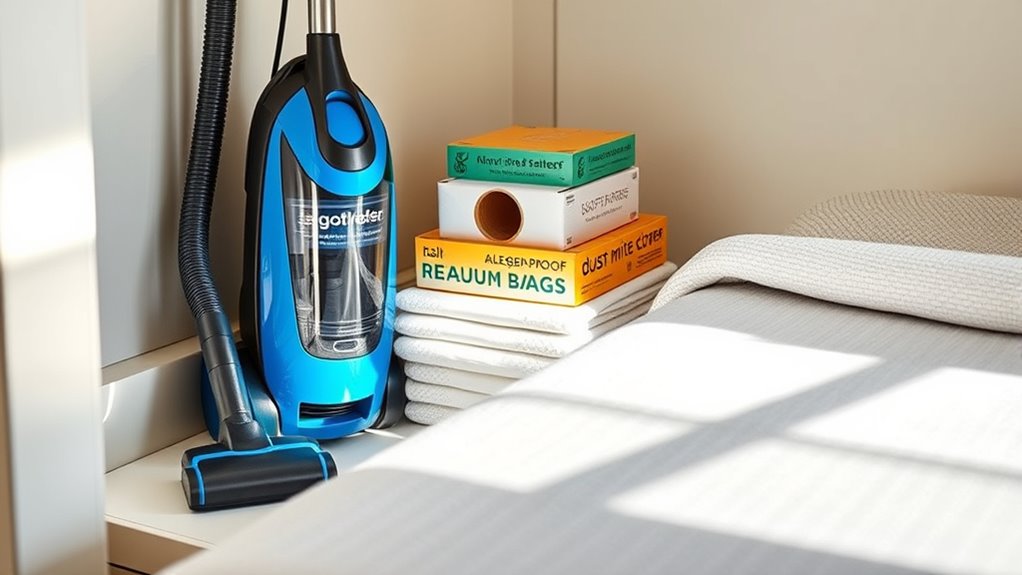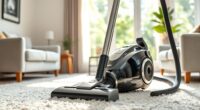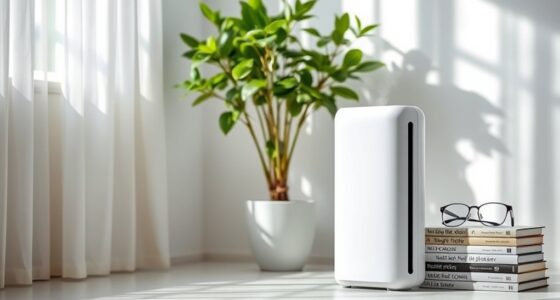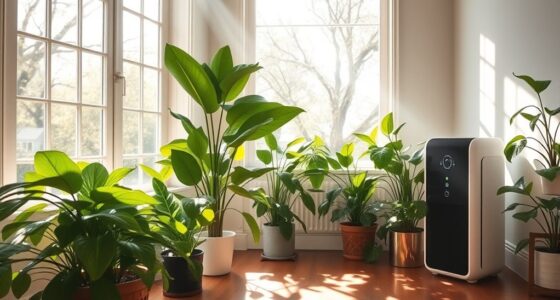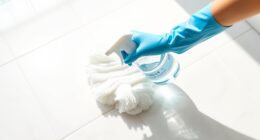To improve your allergy vacuum on a budget, start by upgrading to HEPA filters, which trap tiny allergens like dust mites and pollen effectively. Check hoses and filters regularly for blockages, sealing any leaks with simple materials to boost suction. Use affordable attachments like crevice tools and upholstery brushes to reach tricky spots and capture allergens better. These easy, low-cost steps can make a big difference, and if you keep exploring, you’ll discover even more effective ways to breathe easier.
Key Takeaways
- Upgrade to affordable HEPA filters for your vacuum to trap tiny allergens without replacing the entire unit.
- Regularly check and clear hoses and filters to maintain strong suction and prevent allergen buildup.
- Use inexpensive attachments like crevice tools and upholstery brushes to reach and clean hard-to-access areas.
- Seal gaps around hoses and attachments with rubber gaskets or weatherstripping to improve suction efficiency.
- Pair vacuum upgrades with air purifiers equipped with HEPA filters for enhanced allergen reduction cost-effectively.
Upgrade Your Vacuum Filter on a Budget
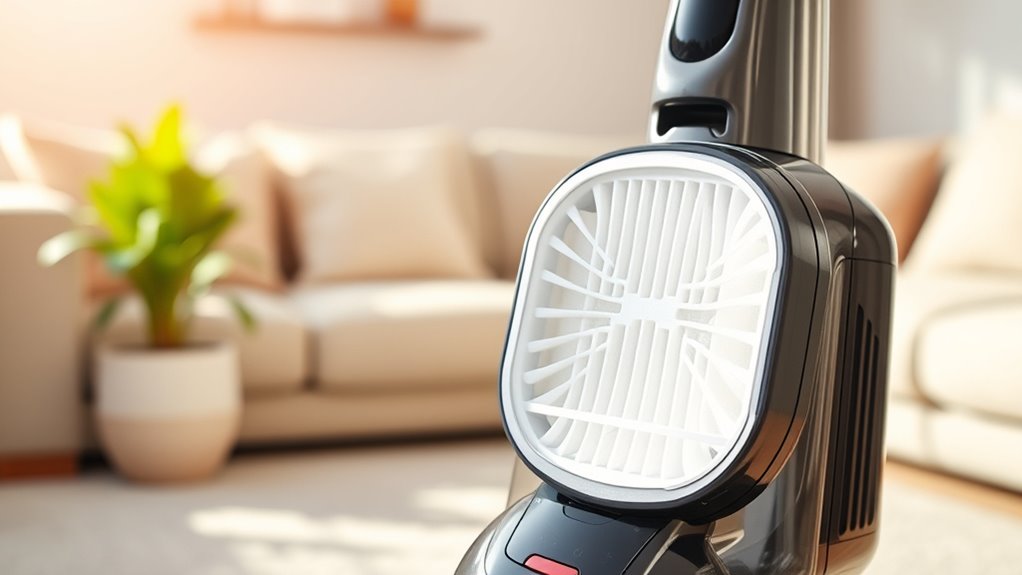
Upgrading your vacuum filter doesn’t have to be expensive. One simple way to improve your vacuum’s allergy-fighting ability is by switching to HEPA filters. These filters trap tiny particles, including dust mites, pet dander, and pollen, making your home cleaner and healthier. Many vacuums are compatible with affordable HEPA filter replacements, so you don’t need to buy a new machine. Additionally, consider using air purifiers with HEPA filters in your living spaces to further reduce airborne allergens. These devices complement your vacuum’s efforts and provide continuous air purification. By upgrading your filters and adding air purifiers, you create a cleaner environment without breaking the bank, making allergy relief more accessible and effective.
Enhance Suction Power With DIY Solutions

Boosting your vacuum’s suction power can make a noticeable difference in allergy relief without spending much. One effective DIY approach is airflow optimization—check for blockages in hoses and filters and clear them out. You can also improve suction by creating DIY seal enhancements around the vacuum’s hose or attachments. Use affordable materials like rubber gaskets or weatherstripping to seal gaps, preventing air leaks that weaken suction. Ensuring a tight seal allows your vacuum to draw in more allergens and debris efficiently. Regularly inspecting and maintaining these seals and airflow pathways keeps your vacuum functioning at its best. Additionally, proper maintenance practices help prolong the lifespan of your vacuum and sustain optimal performance. These simple DIY solutions boost suction power without extra costs, helping you clean more thoroughly and reduce allergy triggers effectively.
Use Affordable Attachments to Capture More Allergens
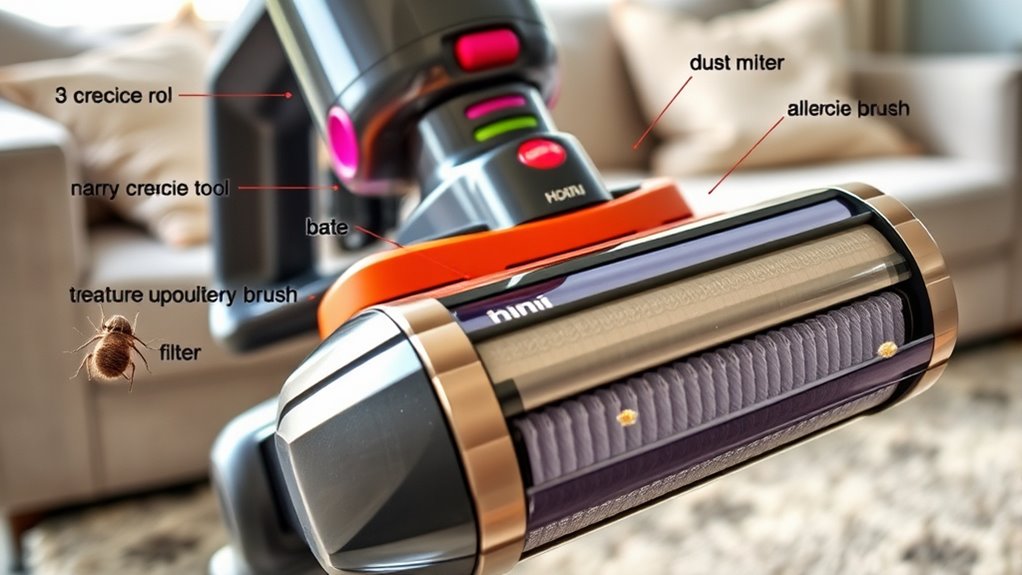
Using affordable attachments can substantially improve your ability to capture allergens during cleaning. Attachments like crevice tools and upholstery brushes help reach tight spaces and soft surfaces, trapping more dust and pet dander. Pair these with HEPA filters in your vacuum to trap tiny particles effectively. Wearing allergen masks while cleaning protects you from airborne allergens, especially if your vacuum isn’t equipped with high-grade filters.
| Attachment Type | Benefits |
|---|---|
| Crevice tools | Reach corners and tight spaces |
| Upholstery brushes | Capture allergens from furniture |
| HEPA filters | Trap microscopic allergens |
| Allergen masks | Protect you from dust during cleaning |
Frequently Asked Questions
Can Using Natural Remedies Help Reduce Allergies Alongside Vacuuming?
Yes, using natural remedies can help reduce allergies alongside vacuuming. Herbal remedies like eucalyptus or peppermint can soothe respiratory issues, while air purifiers trap airborne allergens and improve air quality. Combining these natural approaches with regular vacuuming helps create a healthier environment. You’ll notice fewer allergy symptoms as these remedies work together to reduce dust, pet dander, and other irritants, making your space more comfortable.
Are There Specific Budget-Friendly Vacuum Brands Recommended for Allergy Sufferers?
Did you know that 30% of allergy sufferers find budget-friendly allergy vacuums effective? When shopping for affordable vacuum brands, look for options like Eureka, Dirt Devil, or Bissell, which are known for their budget-friendly allergy vacuums. These brands offer powerful filtration systems at lower prices, helping you reduce allergens without overspending. You can enjoy cleaner air and a healthier home without breaking the bank.
How Often Should I Replace Vacuum Filters for Optimal Allergy Control?
You should replace your vacuum filter every 3 to 6 months for maximum allergy control. Regular vacuum filter maintenance ensures your allergy-friendly vacuum features work effectively, trapping allergens better and maintaining suction power. If you have pets or allergens are a concern, consider replacing filters more frequently. Check your vacuum’s manual for specific recommendations, and choose filters designed for allergy sufferers to improve air quality and reduce allergy symptoms.
Do Homemade Vacuum Sealants Improve Allergen Removal?
Think of homemade vacuum sealants as a band-aid on a leaky faucet—they might offer some temporary relief but don’t fix the root problem. They don’t markedly improve allergen removal or enhance vacuum maintenance. Instead, focus on replacing filters regularly and ensuring your allergen traps are clean. Proper maintenance is your best tool to keep allergens at bay and breathe easier in your home.
Are There Simple Storage Tips to Prevent Allergen Buildup in Vacuums?
To prevent allergen buildup in your vacuum, store it in a clean, dry area to promote proper vacuum storage. Regularly empty and clean the vacuum bag or canister, and check filters for dirt and dust. Make sure to keep the vacuum’s brushes and attachments free of debris. These simple steps enhance allergen prevention, ensuring your vacuum remains effective and your indoor air stays healthier.
Conclusion
With these budget-friendly tips, your vacuum becomes a powerful ally in the fight against allergies. Upgrading filters, boosting suction with DIY tricks, and adding affordable attachments are like giving your vacuum a superhero cape—making it more effective without breaking the bank. Keep your home allergen-free and breathe easier, all while saving money. Remember, a little effort goes a long way in turning your ordinary vacuum into a mighty allergen-fighting machine.
